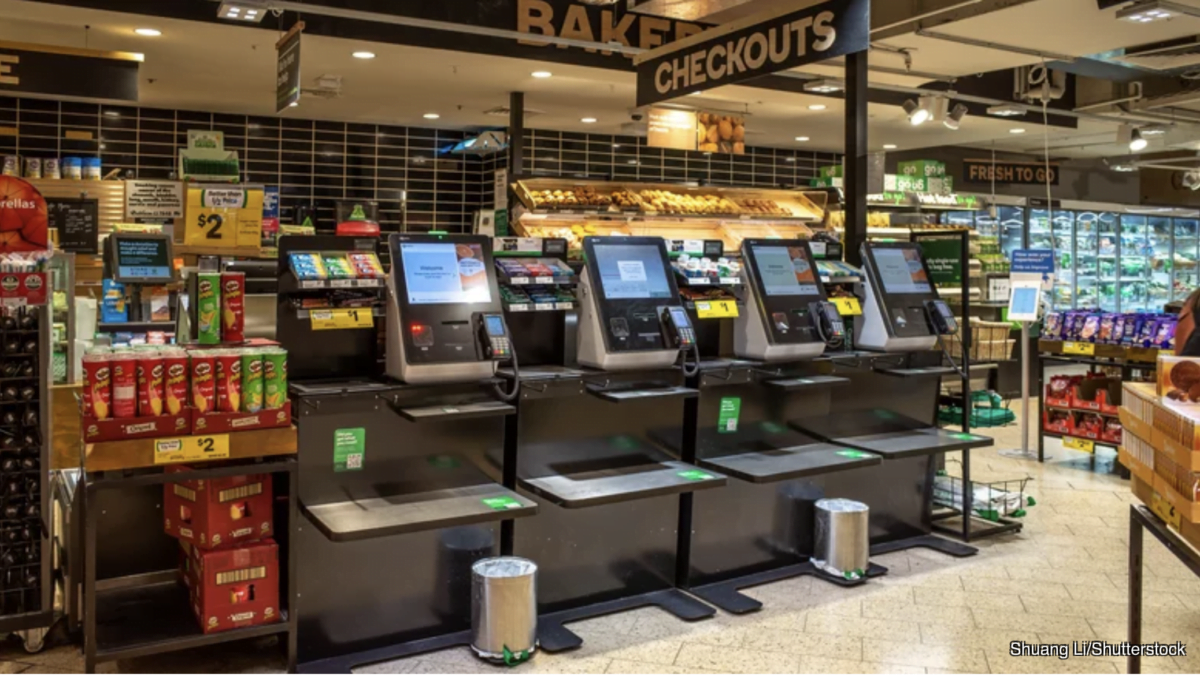Self-checkouts have long been the unloved of retail. In the beginning nothing worked as it should, especially at the grocery store where an order for 20 items brought a new form of despair. Even if the presence of self-checkouts bothered many, Canadians have now apparently befriended them in some way.
Less than a year ago, data from Dalhousie University indicated that, for the first time, self-checkouts were becoming the preferred option for customers when leaving the grocery store. No less than 53.2% of Canadians were identified as intending to use self-checkouts regularly in the future. For young people, 60.1% of Gen Z (born between 1997 and 2005) and Millennials (born between 1981 and 1996) planned to use more of these tills without a cashier. Before the pandemic, in 2019—according to CivicScience—only 19% of customers aged 55 and older felt ready to use self-checkout checkouts, compared to 35% of customers aged 35 to 54. At the time, cashiers remained the preferred option for all demographics. Consumers used to love to hate these machines. Today, things have changed.
All told, self-checkouts are becoming more popular than ever, even surpassing serviced checkouts. According to a survey conducted by Dalhousie University, in partnership with Caddle in early May, a whopping 75% of Canadians have used self-checkouts while visiting the grocery store at least once in the past six months. Moreover, 85.1% of Canadians said they were satisfied with their experience. Interestingly, 47% of Canadians say they are willing to visit a cashier-less grocery store where all purchases are captured by digital sensors that allow consumers to add what they want to their basket and leave the premises without going through any checkouts at all. Amazon Go is the most well-known model for this right now. That number was much lower before the pandemic.

Technology is increasingly being accepted by consumers at the grocery store. But the technology itself is also improving, becoming more intuitive and efficient. Instead of just offering to consumers another option to exit the store while dealing with the optics of seeing machines stealing jobs, grocers are clearly committed now and are no longer holding back.
During the pandemic, cashiers were considered heroes, and everyone wished them a raise. The big chains have even been criticized by our elected officials for abandoning certain compensation programs that offered employees better conditions. The reality though, is that hiring and retaining staff remains challenging. It’s even worse with our labour shortage situation. Automation and robotics are slowly becoming priorities in the agri-food sector, especially in both the food service and retail industries.
For consumers, once choices are made, few want to wait in line to pay. Waiting to pay for your groceries is so 2019. Some want to chat and socialize, of course, but many just want to get what they need as quickly as possible and then socialize elsewhere. Nothing wrong with that either.

Food retailers, along with all of us, are accepting the fact that the labour market is changing and workers in the agri-food sector will want to perform different, more sophisticated tasks and functions that require advanced knowledge and skills. Gone are the days of hiring people to do repetitive tasks. In short, machines are replacing jobs that no one wants to fill.
With these technologies however, we are asking customers to do more work, without compensation. Financial institutions made a major shift decades ago with ATMs. At the time, customers were asked to do more while promising lower bank charges. We now know that quite the opposite has happened.
Unlike banks, the work done in grocery stores is a matter of food safety and security. The cost of food and how it’s handled matters a great deal to everyone. If self-checkouts mean **higher **prices in the future, consumers don’t benefit. But grocers will. The idea of taxing companies that opt for this kind of technology and directly affecting consumers has been floated from time to time. It’s now time to revisit the concept. Or at least, why not offer a reward or incentive for using these machines, such as actual money or discounts. If consumers must do more work during each visit to the store, they must also benefit from it, one way or another. Technologies will redefine the social contract grocers have with all of us. With more technologies, our rapport with grocers will change. It’s not a bad thing, as long as consumers benefit, somehow.







Automated checkouts are all very well and good, if you do not happen to be disabled. My partner is blind, and she could not use one of these without help.
She would much prefer to use a cashier, as do I. These self-checkouts are nothing but an excuse for retailers to continue lowering staff numbers and wages, that’s the be-all and end-all of it. If retailers ever switch to an Amazon-type model, where the entire store is automated, then she would not be able to shop independently.
I personally hate self-checkouts. At my local Loblaws City Market (Manulife Centre), only two checkouts were open today. Shoppers Drug Mart is even worse, often with no person at the till at all. The message is sends is that the retailer does not care about its customers, and I’m thinking I may just start shopping online for groceries etc. given how some retailers seem to care more about the bottom line than actually serving its consumer base in a meaningful way.
Was a shoppers a few monthas ago and was told to use the self check out by and extermely rude cashier as a mostly cash buyer and over 70 I am not comfortable with this technology , I left my items at the till and left and will never set foot in a shoppers again , or any store that forces this on people .
Shoppers Drug Mart absolutely pisses me off, I’ve started shopping at Rexall. The fact that Shoppers encourages its staff to stock shelves/do other things and not be at the tills gives the appearance that it does not care about its customers. Clearly the plan is to phase out humans at cash registers and I think it’s terrible.